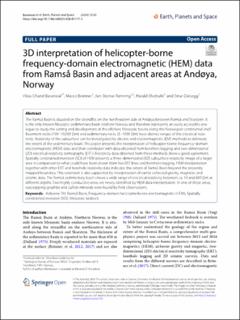| dc.contributor.author | Baranwal, Vikas Chand | |
| dc.contributor.author | Brönner, Marco | |
| dc.contributor.author | Rønning, Jan Steinar | |
| dc.contributor.author | Elvebakk, Harald Kristian | |
| dc.contributor.author | Dalsegg, Einar | |
| dc.date.accessioned | 2022-05-10T11:45:03Z | |
| dc.date.available | 2022-05-10T11:45:03Z | |
| dc.date.created | 2020-06-17T13:20:21Z | |
| dc.date.issued | 2020 | |
| dc.identifier.citation | Earth Planets and Space. 2020, 72 (52), 1-14. | en_US |
| dc.identifier.issn | 1343-8832 | |
| dc.identifier.uri | https://hdl.handle.net/11250/2995065 | |
| dc.description.abstract | The Ramså Basin is situated on the strandflat on the northeastern side of Andøya between Ramså and Skarstein. It is the only known Mesozoic sedimentary basin onshore Norway and therefore represents an easily accessible analogue to study the setting and development of the offshore Mesozoic basins along the Norwegian continental shelf. Basement rocks (100–10,000 Ωm) and sedimentary rocks (5–1000 Ωm) have distinct ranges of the electrical resistivity. Resistivity of the subsurface can be investigated by electric and electromagnetic (EM) methods to delineate the extent of the sedimentary basin. This paper presents the interpretation of helicopter-borne frequency-domain electromagnetic (HEM) data and their correlation with data obtained from borehole logging and two-dimensional (2D) electrical resistivity tomography (ERT). Resistivity data obtained from these methods show a good agreement. Spatially constrained inversion (SCI) of HEM presents a three-dimensional (3D) subsurface resistivity image of a larger area in comparison to what could have been drawn from few ERT lines and borehole logging. HEM interpretation together with other ERT and borehole resistivity data indicates the extent of Ramså Basin beyond the presently mapped boundary. This extension is also supported by interpretation of earlier collected gravity, magnetic and seismic data. The Ramså sedimentary basin shows a wide range of electrical resistivity between ca. 10 and 600 Ωm at different depths. Two highly conductive areas are newly identified by HEM data interpretation. In one of these areas, outcropping graphite and sulfide minerals were found by field observations. | en_US |
| dc.language.iso | eng | en_US |
| dc.publisher | Springer | en_US |
| dc.rights | Navngivelse 4.0 Internasjonal | * |
| dc.rights.uri | http://creativecommons.org/licenses/by/4.0/deed.no | * |
| dc.title | 3D interpretation of helicopter-borne frequency-domain electromagnetic (HEM) data from Ramså Basin and adjacent areas at Andøya, Norway | en_US |
| dc.title.alternative | 3D interpretation of helicopter-borne frequency-domain electromagnetic (HEM) data from Ramså Basin and adjacent areas at Andøya, Norway | en_US |
| dc.type | Peer reviewed | en_US |
| dc.type | Journal article | en_US |
| dc.description.version | publishedVersion | en_US |
| dc.source.pagenumber | 1-14 | en_US |
| dc.source.volume | 72 | en_US |
| dc.source.journal | Earth Planets and Space | en_US |
| dc.source.issue | 52 | en_US |
| dc.identifier.doi | 10.1186/s40623-020-01177-3 | |
| dc.identifier.cristin | 1815963 | |
| cristin.ispublished | true | |
| cristin.fulltext | original | |
| cristin.qualitycode | 1 | |

